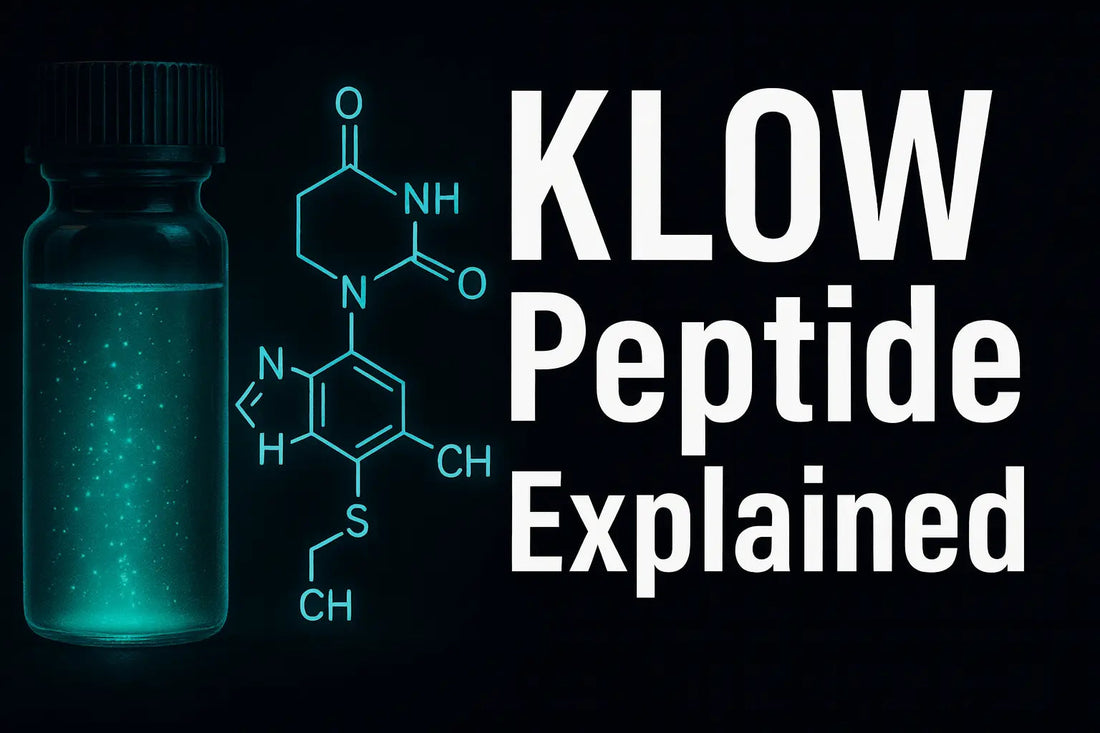
Klow Peptide: A Complete Guide to Synergistic Peptide Combinations
Share
How can combining multiple peptides unlock enhanced healing and recovery? The klow peptide blend, which includes BPC-157, TB-500, KPV, and GHK-Cu, has attracted significant interest for its potential synergistic effects on tissue regeneration and inflammation modulation. Research shows that when these peptides are combined, their distinct mechanisms collaborate to support various biological pathways critical for repairing damage and promoting wellness. This guide dives deep into how this multi-peptide complex works, its research-backed benefits, and why studying these interactions advances our understanding of peptide therapy applications.
Understanding the Klow Peptide Composition and Its Significance
What Is Klow Peptide?
The klow peptide represents a unique multi-peptide blend that combines four well-studied peptides—BPC-157, TB-500, KPV, and GHK-Cu—in a single formulation designed for research into tissue and wound healing, inflammation reduction, and immune modulation. Each of these peptides plays a specialized role, allowing for a comprehensive exploration of regenerative effects on cellular and extracellular environments.
Individual Components and Purity Profile
- BPC-157: Known as the Body Protection Compound, this peptide has been investigated extensively for its capacity to promote tendon, muscle, and gut repair.
- TB-500: A synthetic fragment of thymosin beta-4, TB-500 influences cellular motility by regulating actin, facilitating wound remodeling and fibrosis control.
- KPV: A tripeptide fragment derived from α-MSH, KPV has demonstrated promise in downregulating pro-inflammatory cytokines and modulating immune responses.
- GHK-Cu: A copper-binding tripeptide implicated in collagen synthesis, angiogenesis, skin regeneration, and antioxidant activity.
This blend is supplied as a lyophilized powder with ≥99% HPLC-verified purity, ensuring consistency for research applications. Researchers can explore these peptides' combined effects further using high-grade peptide blends designed for stability and reproducibility.
Synergistic Mechanisms of Klow Peptide Components
Coordinated Tissue Regeneration
BPC-157 and TB-500 collaborate synergistically by promoting angiogenesis and facilitating fibroblast migration, essential steps for the repair of muscles, ligaments, tendons, and the extracellular matrix. BPC-157 stimulates new blood vessel formation, while TB-500 aids cellular movement and wound remodeling, resulting in accelerated tissue repair.
Inflammation Modulation and Immune Balance
The tripeptide KPV exerts potent anti-inflammatory action by inhibiting nuclear factor kappa B (NF-κB) pathways, reducing pro-inflammatory cytokine release. This effect is complemented by the anti-inflammatory properties of both BPC-157 and TB-500, which collectively downregulate inflammatory mediators and promote a balanced immune response. GHK-Cu additionally contributes by reducing oxidative stress and fostering an environment conducive to healing.
Research-Backed Benefits of Klow Peptide in Laboratory Settings
- Enhanced Wound Healing: Studies suggest the combination expedites wound closure and reduces scar formation through coordinated cell proliferation and collagen synthesis.
- Skin and Connective Tissue Repair: GHK-Cu’s stimulation of collagen and elastin synergizes with the regenerative effects of BPC-157 and TB-500 to improve skin integrity and elasticity.
- Reduction of Chronic Inflammation: KPV and the other peptides' immune-modulating effects support research into managing conditions characterized by excessive inflammation.
- Improved Cellular Migration and Tissue Remodeling: TB-500 enhances actin dynamics, facilitating cell movement necessary for efficient tissue repair.
- Potential Gut and Mucosal Repair: BPC-157's research profile includes intestinal healing, which may be amplified by the combined peptide action in the klow blend.
These benefits underscore the advantage of multi-peptide interactions over single-agent use in laboratory explorations of tissue regeneration and inflammation control.
Storage, Handling, and Usage Recommendations for Researchers
Optimal Storage Conditions
Klow peptide is provided as a blue-colored freeze-dried powder that should be stored at -20°C in a sealed container to maintain stability. Once reconstituted with bacteriostatic water, storage at 2-8°C is recommended, and the solution should be used promptly to preserve activity.
Best Practices for Preparation
- Utilize aseptic techniques to avoid contamination during reconstitution.
- Gently swirl the vial until fully dissolved; avoid vigorous shaking.
- Avoid repeated freeze-thaw cycles to prolong peptide integrity.
- Accurately measure dosage suitable for the intended experimental design.
Comparative Insights: Why Combination Peptide Research Matters
Advantages Over Single-Peptide Studies
Research indicates that the combined application of BPC-157, TB-500, KPV, and GHK-Cu may produce amplified regenerative and immune-modulating effects compared to each peptide alone. This synergy allows simultaneous targeting of multiple healing pathways, such as angiogenesis, cellular migration, inflammation regulation, and collagen production.
Emerging Research Challenges and Opportunities
While individual peptides have documented mechanisms, comprehensive clinical data on the combined klow peptide effects remain sparse. Ongoing laboratory studies aim to clarify optimal ratios, dosing schedules, and interaction profiles, paving the way for enhanced regenerative medicine protocols.
Key Applications and Future Research Directions
Potential Areas for Investigation
- Musculoskeletal injury repair and rehabilitation models.
- Management of chronic inflammatory states and autoimmune diseases.
- Skin aging and cosmetic dermatology research.
- Gastrointestinal mucosal healing in inflammatory bowel disease models.
- Immune regulation and balance in complex systemic conditions.
Call for Continued Scientific Exploration
Advancing research on the klow peptide blend’s synergistic actions will be pivotal for translating these findings into practical clinical interventions. With robust purity standards and validated manufacturing, products like these represent reliable tools for researchers committed to unraveling the complexities of tissue regeneration and immune modulation.
In conclusion, the klow peptide blend harnesses the complementary strengths of BPC-157, TB-500, KPV, and GHK-Cu, offering a multifaceted approach to healing and inflammation management. By understanding its unique composition, mechanisms, and research potential, scientists can better explore novel therapeutic pathways. To delve deeper into the possibilities offered by such peptide blends, explore high-purity multi-peptide research formulations suited for advancing regenerative studies.

